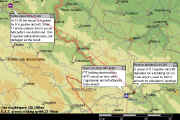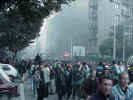Details of the attack of Yugoslav aircraft on Tuzla
airport in Bosnia-Herzegovina on April 18, 1999 April 30, 1999
 On
April 18, 1999 at 13:30 local time a strike force of nine Yugoslavian aircraft, consisting
of one G-4 Super Galeb strike aircraft, six J-22 Orao strike aircraft, and two MiG-21
fighters, conducted a bombing run against the Tuzla airport. The attack was organized
unofficially on the initiative of the Yugoslavian pilots involved. The strike was led by
an unidentified Major Stevan Zivojin Gavrilovic of the Yugoslavian Air Force, flying a G-4
Super Galeb and organized by Lt. Colonel M.V. from Kragujevac, flying one of the Oraos.
The strike was initiated from the Ponikve airbase near the town of Uzice, approximately
120km away from Tuzla. The group of Yugoslav aircraft followed a route along the border
between Yugoslavia and Bosnia-Herzegovina at an altitude of 800m and crossed the border
somewhere between the towns of Bratunac and Zvornik.
On
April 18, 1999 at 13:30 local time a strike force of nine Yugoslavian aircraft, consisting
of one G-4 Super Galeb strike aircraft, six J-22 Orao strike aircraft, and two MiG-21
fighters, conducted a bombing run against the Tuzla airport. The attack was organized
unofficially on the initiative of the Yugoslavian pilots involved. The strike was led by
an unidentified Major Stevan Zivojin Gavrilovic of the Yugoslavian Air Force, flying a G-4
Super Galeb and organized by Lt. Colonel M.V. from Kragujevac, flying one of the Oraos.
The strike was initiated from the Ponikve airbase near the town of Uzice, approximately
120km away from Tuzla. The group of Yugoslav aircraft followed a route along the border
between Yugoslavia and Bosnia-Herzegovina at an altitude of 800m and crossed the border
somewhere between the towns of Bratunac and Zvornik.
Several minutes before the attack the Ponikve base informed the strike
group that they were spotted by NATO forces and the strike group was advised to
discontinue its operation. The suggestion was disregarded and the strike group proceeded
with the planned attack. The Yugoslavian aircraft did not encounter any air or ground
opposition during their approach to the Tuzla airport. The main radar at the Tuzla airport
was not operational due to a technical malfunction (or, according to other sources, due to
a diversion). It was known that beside a several damaged NATO aircraft and rescue
helicopters, a group of additional 10 NATO aircraft arrived to the Tuzla airport for
operations against Yugoslavia, which prompted the improvised strike by Yugoslavian planes.
A group of four NATO aircraft were detected at the far end of the Tuzla
airport, preparing for takeoff. The lead G-4 released its bombs at the group of several
damaged NATO planes positioned at the right side of the runway and immediately turned his
aircraft back toward the border. Three Oraos did the same, while the three remaining Oraos
conducted a precision strike. The two MiG-21s were to provide the strike group with air
cover during the withdrawal, in case any of the NATO planes managed to take off.
The Orao piloted by Lt. Colonel Mihaljo V. was targeted and destroyed
by a NATO SAM. One of the MiG-21s, piloted by Major Zeljko M. from Novi Sad, was hit by a
SAM as well, but the pilot managed to land the aircraft 10km from Ponikve airbase. NATO
lost 17 aircraft and three rescue helicopters on the ground. However, it is not known how
many of those 17 aircraft were operational prior to the strike (as was mentioned earlier,
NATO aircraft used the Tuzla airport for emergency landings.)



